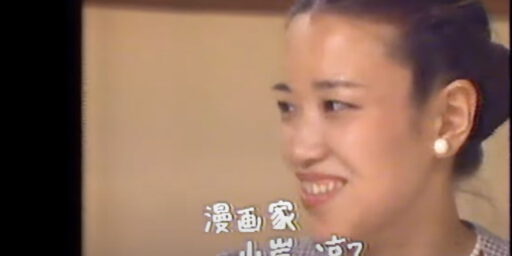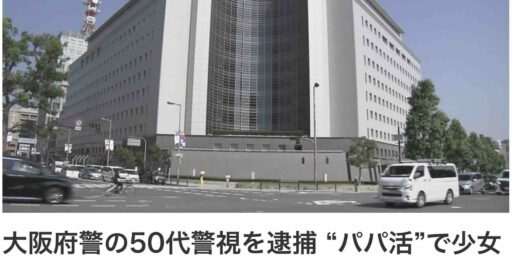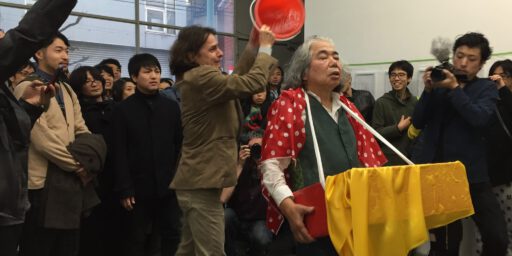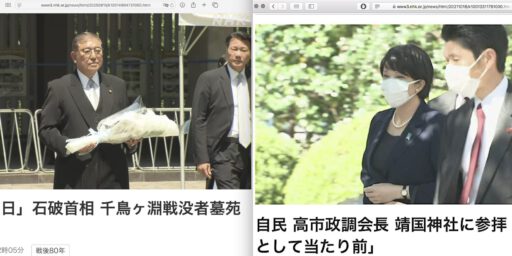自民党ヤクザ:「エサ米」は国民に。「コシヒカリ」はにっぽんエリートに。 (1) LDP Yakuza: Let the Japanese population eat "Feed Rice". For the Elite "Koshihikari". (1)
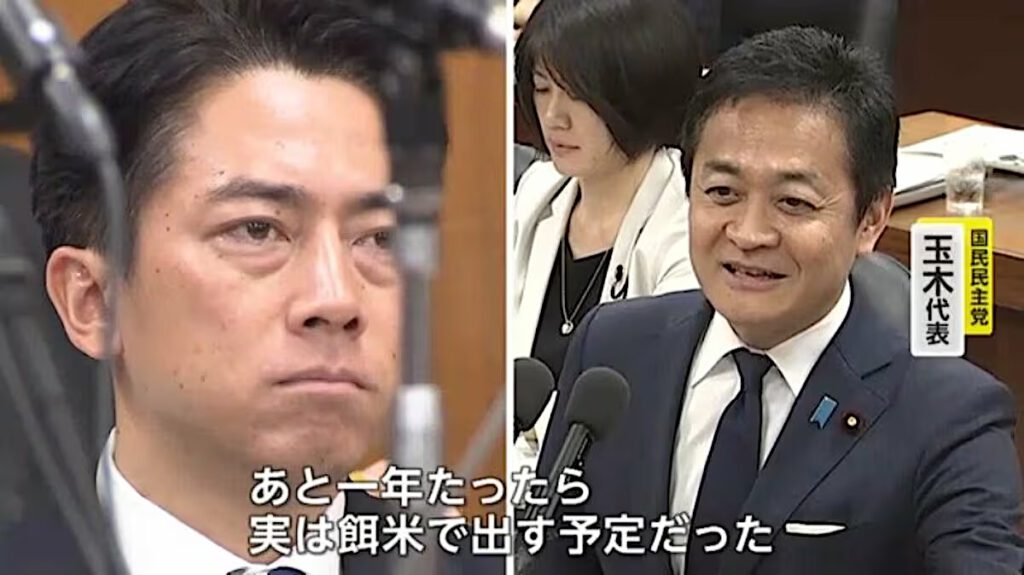
Up-date 2025/5/31
自民党ヤクザ:「エサ米」は国民に。「コシヒカリ」はにっぽんエリートに。 (2)
LDP Yakuza: Let the Japanese population eat “Feed Rice”. For the Elite “Koshihikari”. (2)
https://art-culture.world/articles/japanese-feed-rice-古古古米/
Let them give idols. Let them eat cake. Not this time. Let them eat Japanese Feed Rice for 2.000 Yen (14 US$) per 5 kg.
The Japanese government, through newly appointed Farm Minister KOIZUMI Shinjiro 小泉 進次郎, makes matters worse.
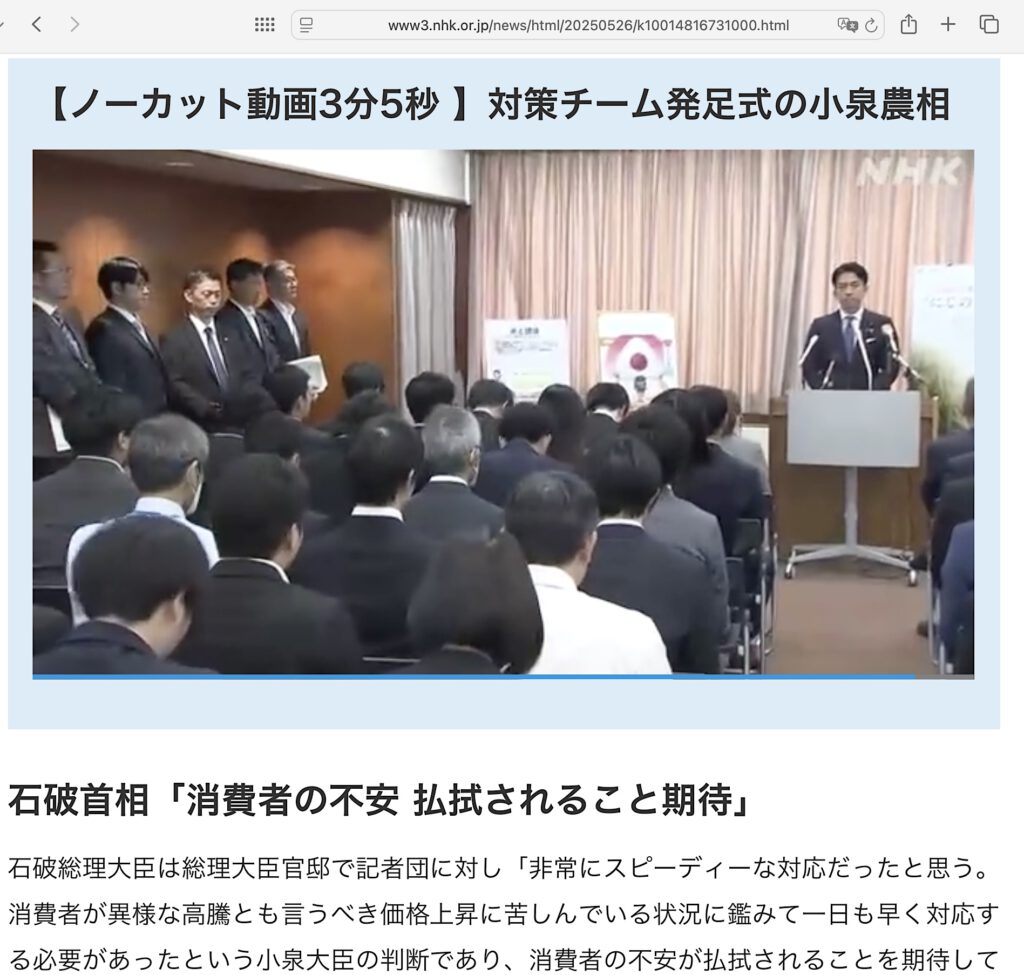
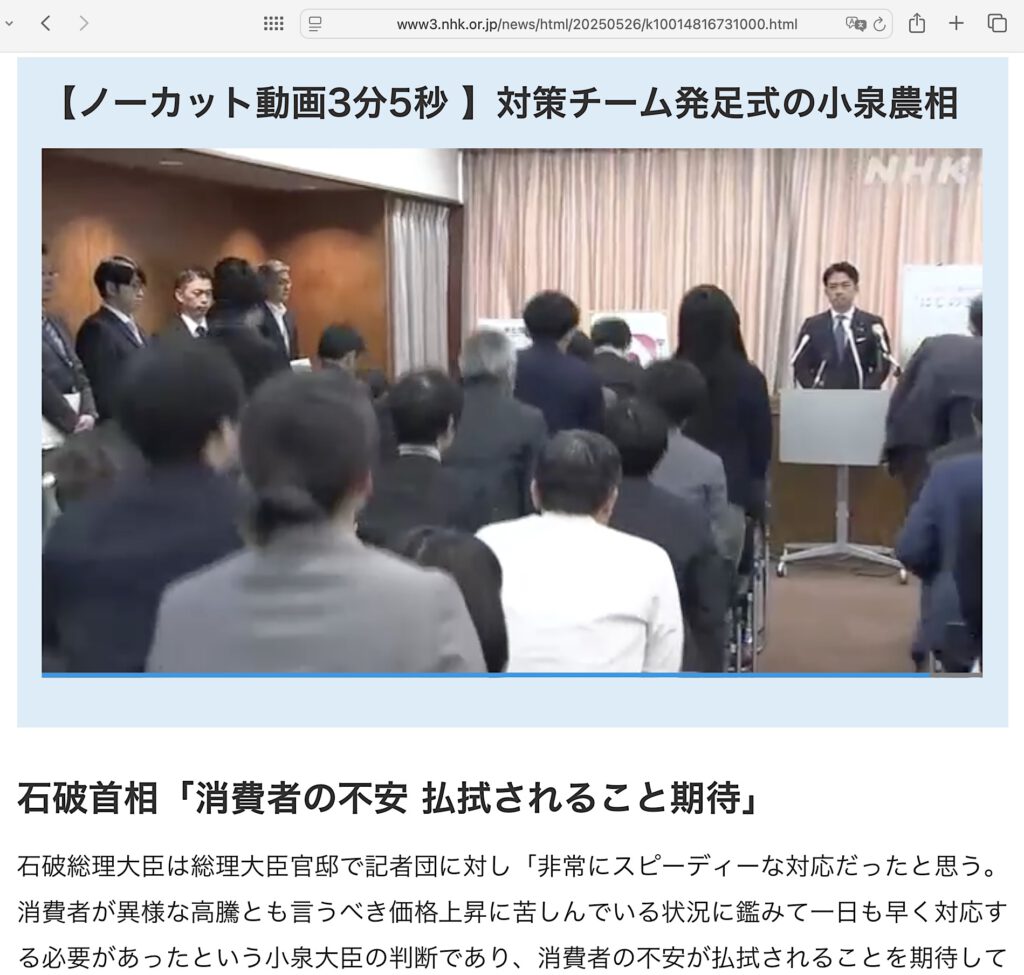

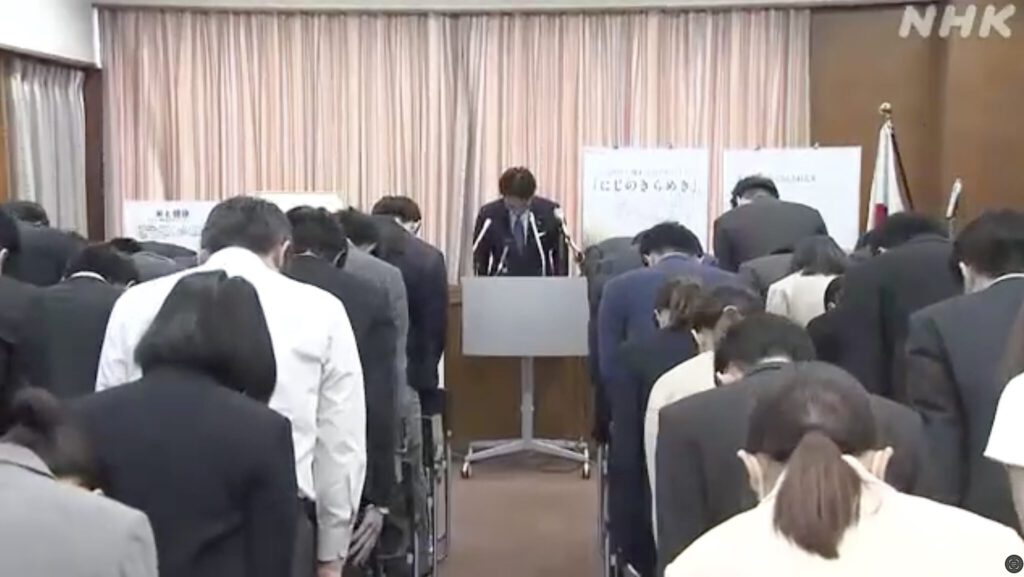
Cheap Feed Rice 飼料用米 / エサ米 (government’s cheap stockpiled rice from 2021 令和3年産, 7 months before normally being auctioned off as true Feed Rice) is being sold to the Japanese population without scruples.

The rich don’t care, as they can easily afford buying “Koshihikari” コシヒカリ for 5.600 Yen (39 US$) per 5 kg.

Google, if you want to understand the differences.
Refer to constantly up-dated:
変態社会にっぽん (5) :お米問題を巡って、にっぽん人が選んだ自民党ヤクザ
Perverted Society Japan (5): Japanese rice issue, LDP Yakuza chosen by Japanese people
https://art-culture.world/articles/hentai-japan-rice-ldp-yakuza/
国民 玉木代表「1年たったらエサ」 “備蓄米の制度を説明”
2025年5月29日 15時41分
備蓄米をめぐり、国民民主党の玉木代表は28日の国会審議で「1年たったら動物のエサになるようなもの」などと発言しました。これについて玉木氏は29日に、5年持ち越した備蓄米は「飼料用米」として売り渡すことになっている現行制度に触れたものだなどと説明しました。
政府の備蓄米をめぐり、国民民主党の玉木代表は28日の国会審議で「1年たったら動物のエサになるようなものを『安く売ります』と言ったって、それは安く出る」などと述べ、ほかの党から「今の局面で使うべきことばではない」などとの指摘が出ています。
玉木代表は、29日に旧ツイッターの「X」に行った投稿で、自身の発言について「5年持ち越した備蓄米は『飼料用米』として売り渡すことになっている現行の制度を説明したものだ。小泉農林水産大臣も『エサ米』ということばを使って同じ説明をしている」としています。
そして「私が言いたかったのは、備蓄米を放出するだけでは石破総理が約束した『コメの平均価格3000円台』は実現できないのではないかということだ」としたうえで、コメの増産や農家の所得の直接補償などへと、政策を転換する必要性を重ねて強調しています。
小泉農相「ちょっと残念だという印象」
農林水産省によりますと、備蓄米は国の指針に基づいて5年程度利用がなかった場合には、家畜のエサなどとして事業者に売り渡されているということです。
玉木代表の発言について小泉農林水産大臣は28日記者団に対し、「ちょっと残念だ。玉木さんは農政を全部分かっているので分かった上での発言だと思うが、事実はそうだとしても、備蓄米の放出に取り組んでいる時に私としてはちょっと残念だという印象だ」と述べました。
https://www3.nhk.or.jp/news/html/20250529/k10014819891000.html
Japan farm minister irked by opposition head describing stockpiled rice as animal feed
May 29, 2025 (Mainichi Japan)
TOKYO — Japan’s agriculture minister complained that an opposition party leader described stockpiled rice as “something that will become animal feed after one year” at the House of Representatives Committee on Agriculture, Forestry and Fisheries on May 28.
In asking a question to agriculture minister Shinjiro Koizumi at the committee meeting, Democratic Party for the People leader Yuichiro Tamaki remarked that “the government says it will sell the rice, which will used to feed animals after a year, at a lower price. Of course, it will be sold at a low price.” He also explained that there is strong demand to buy branded rice such as Koshihikari at lower prices, and commented, “Stockpiled rice does not meet real needs.”
Koizumi told reporters, “Even if that’s the reality, it’s a bit disappointing to hear such remarks at a time when we are working on how to release stockpiled rice.”
According to the Ministry of Agriculture, Forestry and Fisheries website, stockpiled rice is sold as feed rice and for other uses after about five years of storage.
https://mainichi.jp/english/articles/20250529/p2a/00m/0na/019000c
アップデート:
備蓄米売り渡し 中小小売業者などの申請 受け付け始まる
2025年5月30日 10時33分
…
今回の対象は令和3年産 “古古古米”
これを受けて農林水産省は契約の相手を中小の小売業者やコメ販売店とする新たな仕組みに見直し、30日午前10時から申請の受け付けを始めました。
対象となるコメはまだ申請が確定していない令和3年産の8万トンで、年間1000トン以上、1万トン未満の取扱量がある中小の小売業者向けに6万トン、精米設備があるコメの販売店向けには2万トンとしています。
価格は60キロあたり消費税込みで1万886円で、5キロに単純に換算すると907円で売り渡すとしています。
これに一般的な流通経費が上乗せされた店頭での価格について、小泉農林水産大臣はこれまでに「5キロ税抜き1800円程度になるのではないか」と述べています。
申請は平日午前10時から午後5時までメールで受け付けられ、申込量が予定量を上回った場合には農林水産省が調整の上、契約量を決めるということです。
29日に行われた事業者向けの説明会には1000を超える参加があったということで、農林水産省は申請があったところから順次手続きを進めていくとしています。
今回売り渡されるのは「古古古米」と呼ばれる収穫から3年以上たったコメで、どのくらいの申請があるのかが焦点となっています。
https://www3.nhk.or.jp/news/html/20250530/k10014820441000.html
備蓄米売り渡し 中小小売業者などの申請 受け付け始まる
2025年5月30日 20時01分
随意契約による備蓄米の売り渡しについて、中小の小売業者などを相手とする新たな仕組みでの申請の受け付けが始まりました。
今回売り渡されるコメは「古古古米」と呼ばれる令和3年産の8万トンで、どのくらいの申請があるのかが焦点となっています。

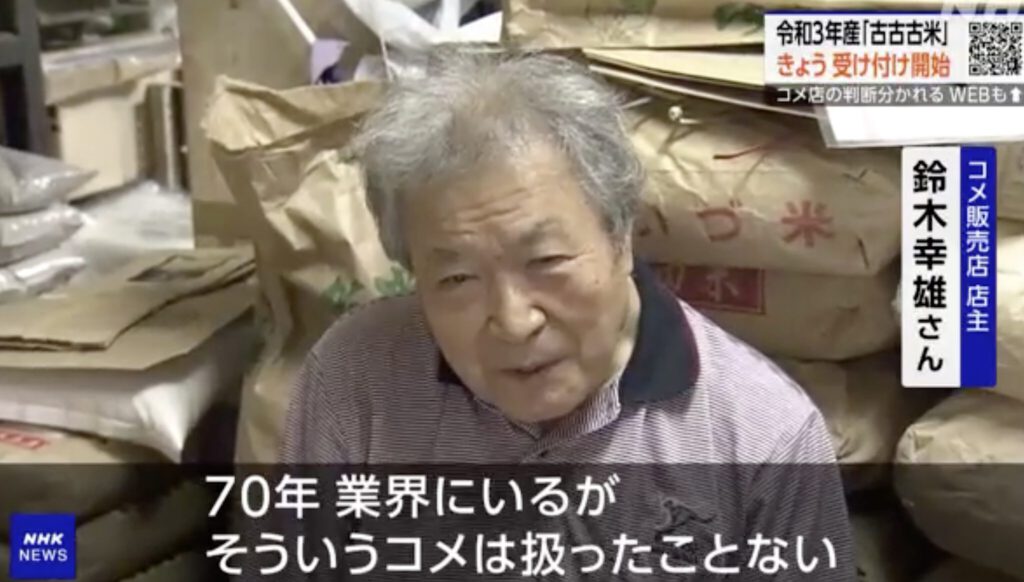
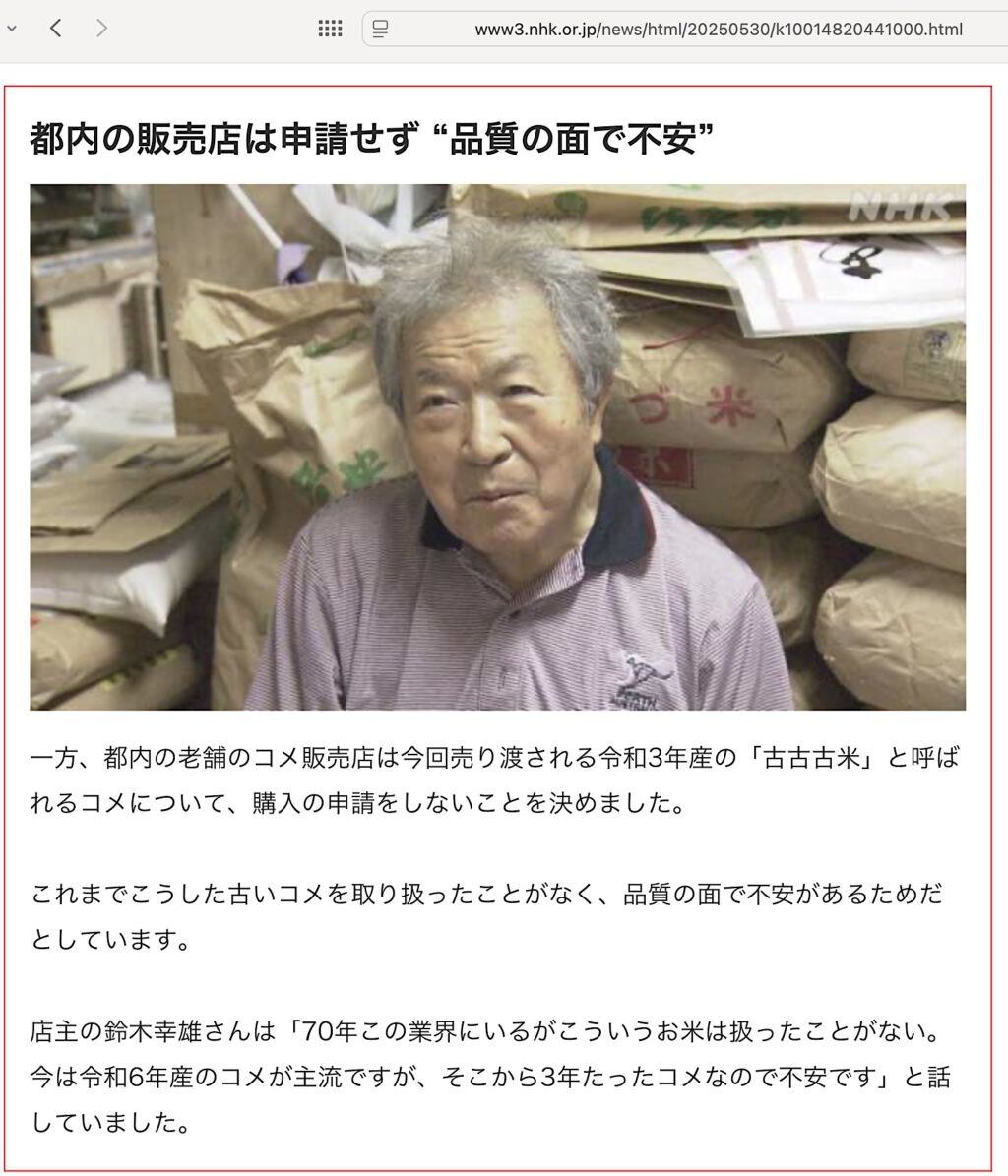
都内の販売店は申請せず “品質の面で不安”
一方、都内の老舗のコメ販売店は今回売り渡される令和3年産の「古古古米」と呼ばれるコメについて、購入の申請をしないことを決めました。
これまでこうした古いコメを取り扱ったことがなく、品質の面で不安があるためだとしています。
店主の鈴木幸雄さんは「70年この業界にいるがこういうお米は扱ったことがない。今は令和6年産のコメが主流ですが、そこから3年たったコメなので不安です」と話していました。
more @
https://www3.nhk.or.jp/news/html/20250530/k10014820441000.html
2025年5月31日のアップデート:
情けない。哀れで、恥ずべきこと。恥辱だ。尊厳が失われた。
Erbärmlich, beschämend. Eine Schande. Die Würde geht verloren.
Pathetic, shameful. A disgrace. Dignity is lost.
お米500袋約30分で売り切れ。
500 Säcke mit 5 Kg Reis waren in 30 Minuten ausverkauft.
500 bags of 5 kg rice sold out in about 30 minutes.

随意契約の備蓄米 販売開始 価格は?コメ値下がりにつながるか
NHK 2025年5月31日 12時18分
随意契約で売り渡された政府の備蓄米について、5月31日から一部の小売店で店頭での販売が始まりました。価格を抑えた備蓄米が広く行き渡り、高騰が続くコメの値下がりにつなげられるかが焦点となっています。
Sales of stockpiled rice under discretionary contracts begin. What will the price be? Will this lead to a drop in rice prices?
NHK May 31, 2025 12:18
The government’s stockpiled rice, which was sold under discretionary contracts, began to be sold at some retail stores from May 31. The focus is on whether the low-priced stockpiled rice will become widely available and lead to a drop in the price of rice, which continues to soar.
イトーヨーカ堂 開店30分で売り切れ
随意契約による備蓄米の売り渡しは令和4年産の20万トン、令和3年産の10万トンのあわせて30万トンを対象に行われ、契約を結んだ一部の事業者は31日から店頭での販売を始めました。
このうち、令和4年産5000キロの契約を結んだ大手スーパーの「イトーヨーカ堂」は東京・大田区の店舗で販売を始めました。
午前8時半に備蓄米を積んだトラックが到着し、従業員が特設の売り場に並べました。
Ito-Yokado sold out in 30 minutes after opening
The sale of stockpiled rice through discretionary contracts was for a total of 300,000 tons, consisting of 200,000 tons of rice from the 2022 crop and 100,000 tons of rice from the 2021 crop, and some businesses that signed contracts began selling them in stores from the 31st.
Of these, Ito-Yokado, a major supermarket chain that signed a contract for 5,000 kg of rice from the 2022 crop, began selling them at its store in Ota Ward, Tokyo.
A truck loaded with stockpiled rice arrived at 8:30 a.m., and employees lined it up in a special sales area.
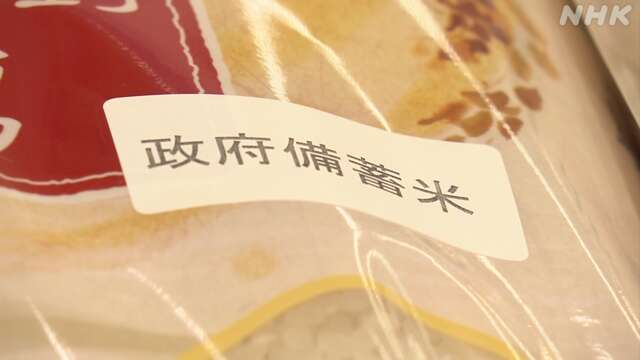
価格は5キロ税込み2160円で、ひと家族1点の購入制限が設けられましたが、用意された500袋は午前10時の開店からおよそ30分で売り切れました。
購入した30代の女性は「コメの価格が高い中、ふだんの半額で買えると聞いて朝から並んだ。ほかのコメの値上がりも落ち着いてほしい」と話していました。
イトーヨーカ堂の山本哲也社長は「リーズナブルなコメを届けたいと思い、随意契約に申し込んだ。ほかのコメの価格の見通しはわからないが、客の選択肢の1つとして提供していきたい」と話していました。
The price was 2,160 yen including tax for 5 kg, and there was a purchase limit of one bag per family, but the 500 bags on offer were sold out about 30 minutes after the store opened at 10 a.m.
A woman in her 30s who purchased some said, “With rice prices being high, I lined up from the morning after hearing I could buy it at half the usual price. I hope the price increases of other types of rice will stabilize.”
Ito-Yokado President Tetsuya Yamamoto said, “We applied for the discretionary contract because we wanted to deliver reasonable rice. We don’t know what the outlook for prices of other types of rice will be, but we would like to offer it as one option for customers.”
アイリスオーヤマも31日の販売終了
随意契約で備蓄米1万トンを購入する契約を締結した大手生活用品メーカーのアイリスオーヤマも31日から宮城県と千葉県の2店舗で販売を始めました。
このうち、仙台市宮城野区の店舗では令和4年産の95袋が5キロ税込み2160円で用意されました。袋には消費者が備蓄米と分かるようシールが貼られています。
店では開店前に整理券を配付しましたが用意した数を超える客が訪れ、31日の販売は終了しました。
店内には試食コーナーも設けられ訪れた客が備蓄米の味や食感を確かめていました。
Iris Ohyama also ended sales on the 31st.
Iris Ohyama, a major household goods manufacturer that signed a discretionary contract to purchase 10,000 tonnes of stockpiled rice, also began selling it at two stores in Miyagi and Chiba prefectures from the 31st.
Of these, a store in Miyagino Ward, Sendai, had 95 bags of the 2022 harvest available for 2,160 yen (tax included) for 5 kg. Stickers were affixed to the bags so consumers could identify them as stockpiled rice.
The store handed out numbered tickets before opening, but more customers showed up than the prepared number, and sales on the 31st ended.
A tasting corner was also set up in the store where customers could try out the taste and texture of the stockpiled rice.
購入した40代の男性は「消費者にとっては価格が安い備蓄米はありがたい。さっそく家で食べてみたい」と話していました。
店の運営会社の大森昭部長は「備蓄米を消費者に届けることができたことはうれしく感じている。今後、多くの店で備蓄米を届けていきたい」と話していました。
随意契約の備蓄米は流通大手の「イオン」も6月1日から販売を始めることにしていて、今後、流通が本格化する見通しです。
価格を抑えた備蓄米が広く行き渡り、高騰が続くコメの値下がりにつなげられるかが焦点となっています。
One man in his 40s who purchased some said, “For consumers, cheap stockpiled rice is a blessing. I’d like to try it at home right away.”
Omori Akira, a manager at the store’s operating company, said, “We are pleased that we were able to deliver stockpiled rice to consumers. We would like to see many stores deliver stockpiled rice in the future.”
Major retailer Aeon will also start selling stockpiled rice under discretionary contracts from June 1, and distribution is expected to get into full swing in the future.
The focus is on whether the reduced-priced stockpiled rice will be widely distributed, leading to a drop in the price of rice, which continues to soar.
https://www3.nhk.or.jp/news/html/20250531/k10014821921000.html
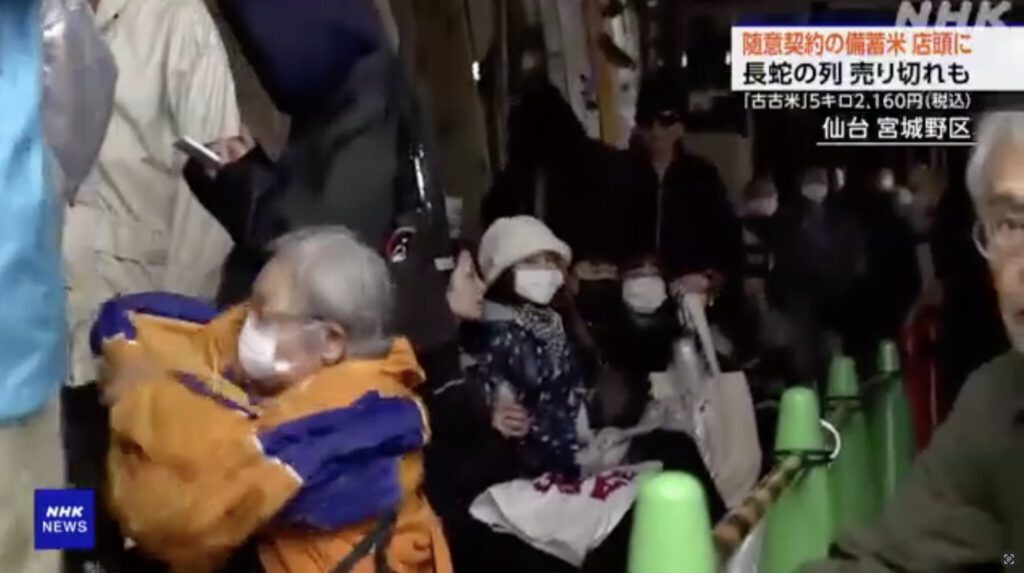

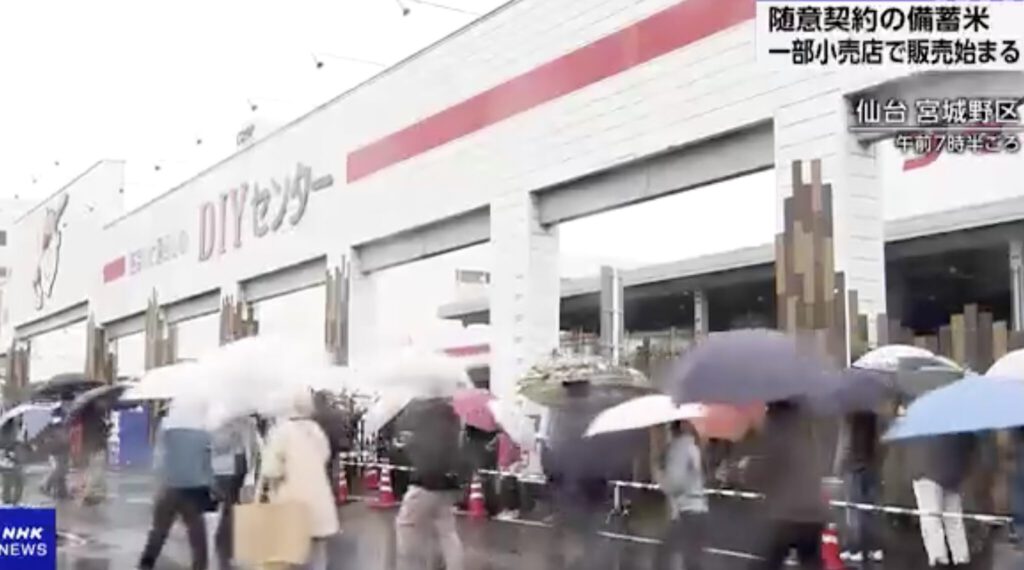


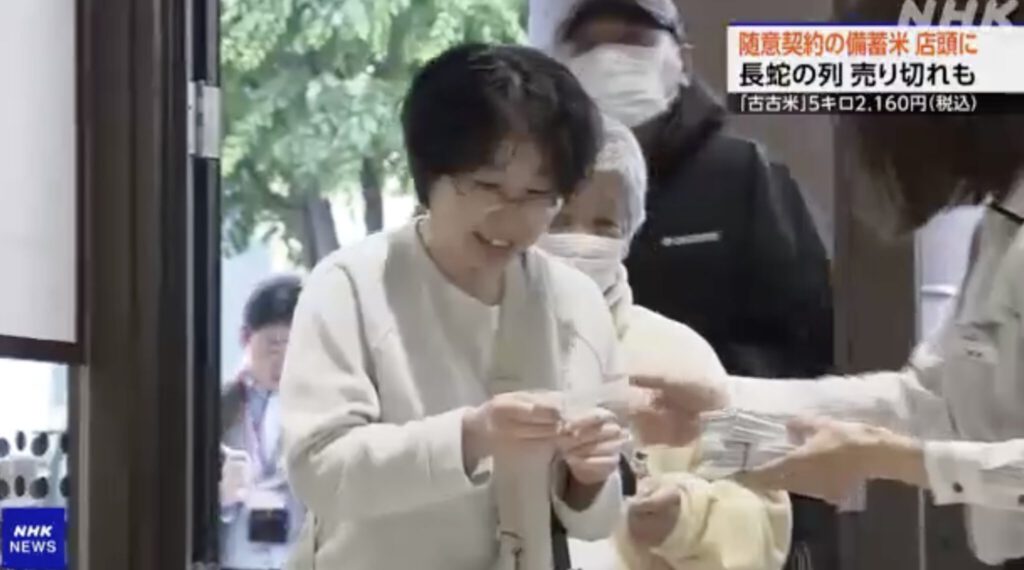

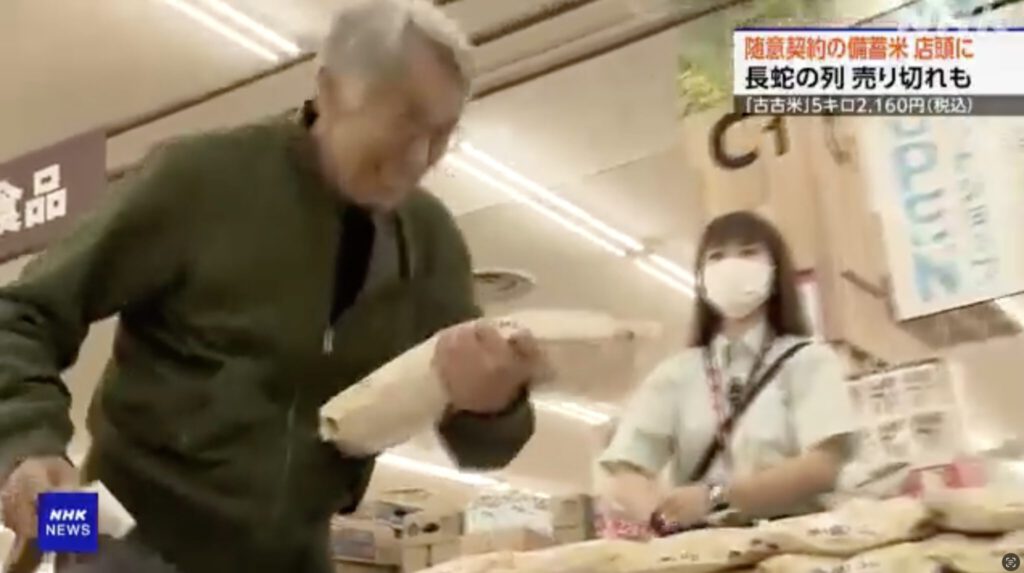
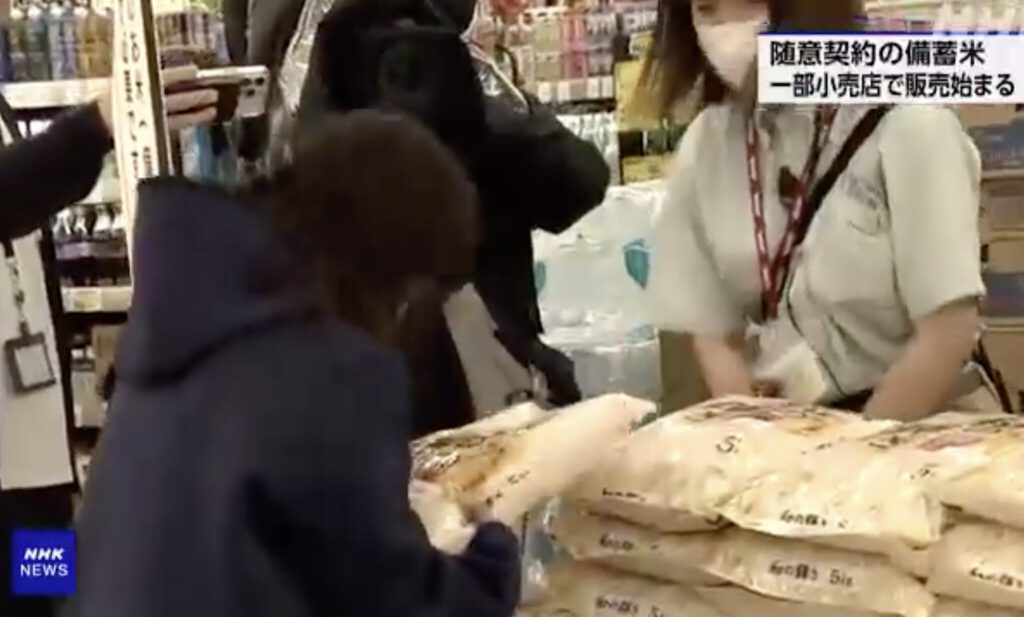
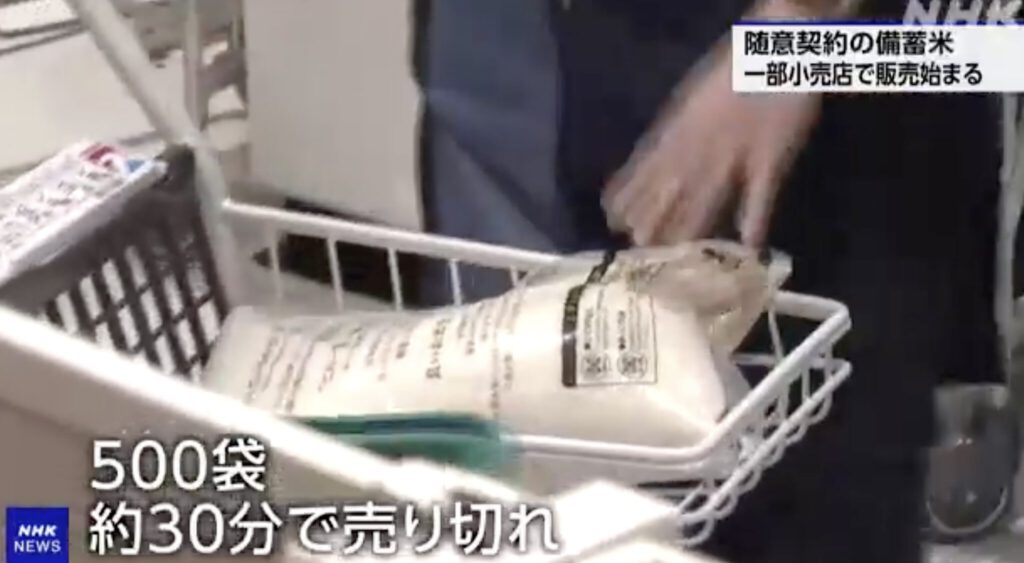
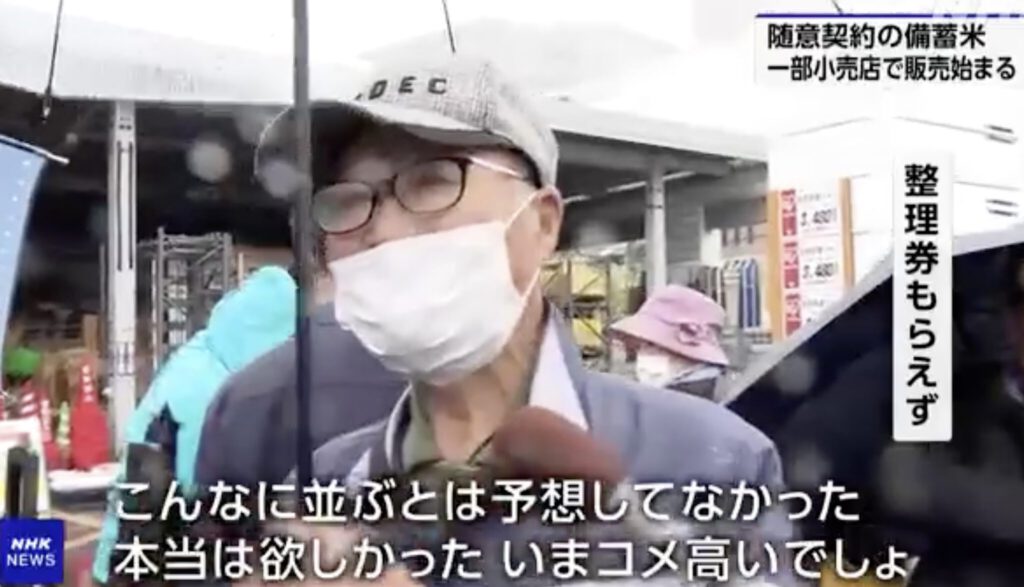
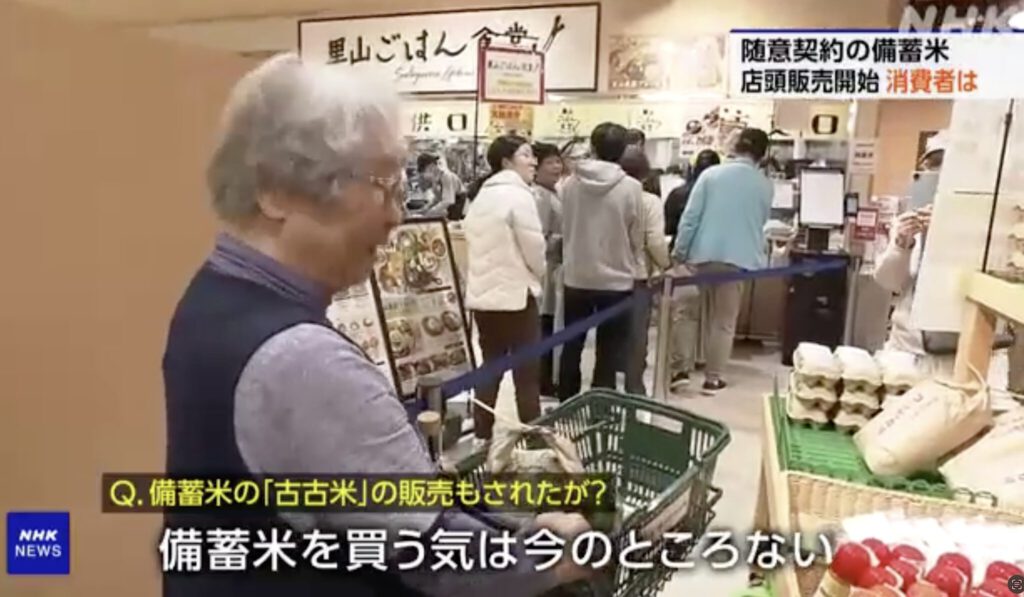
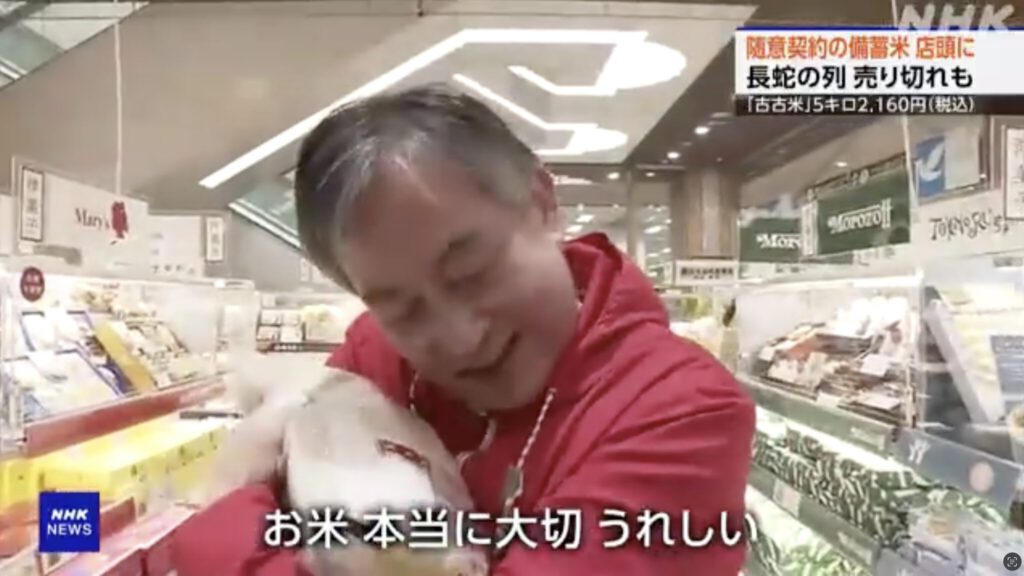
2025年6月1日アップデート:
備蓄米 イオン 随意契約購入分の販売開始 5キロ税込み2100円余
NHK 2025年6月1日 11時42分
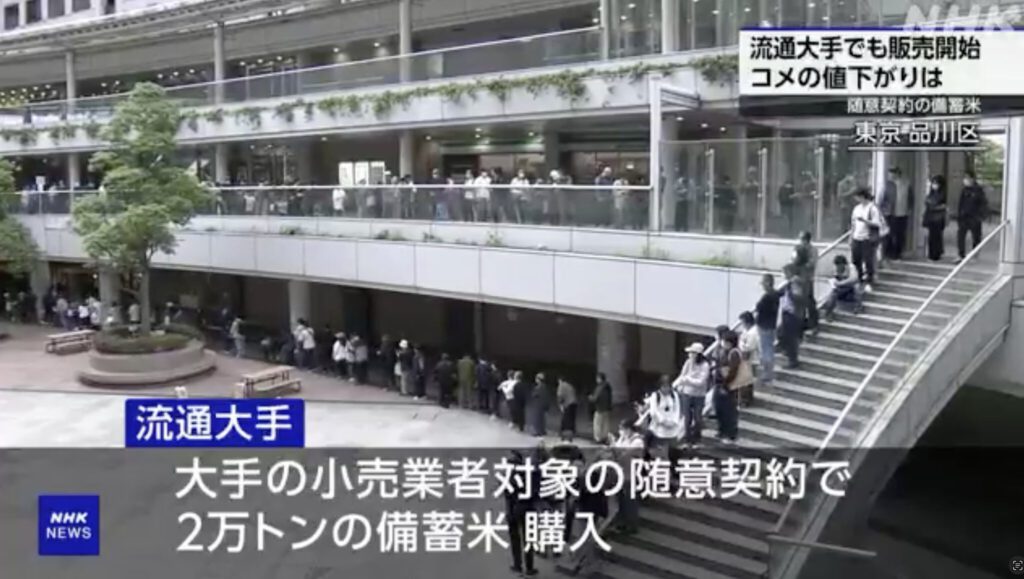
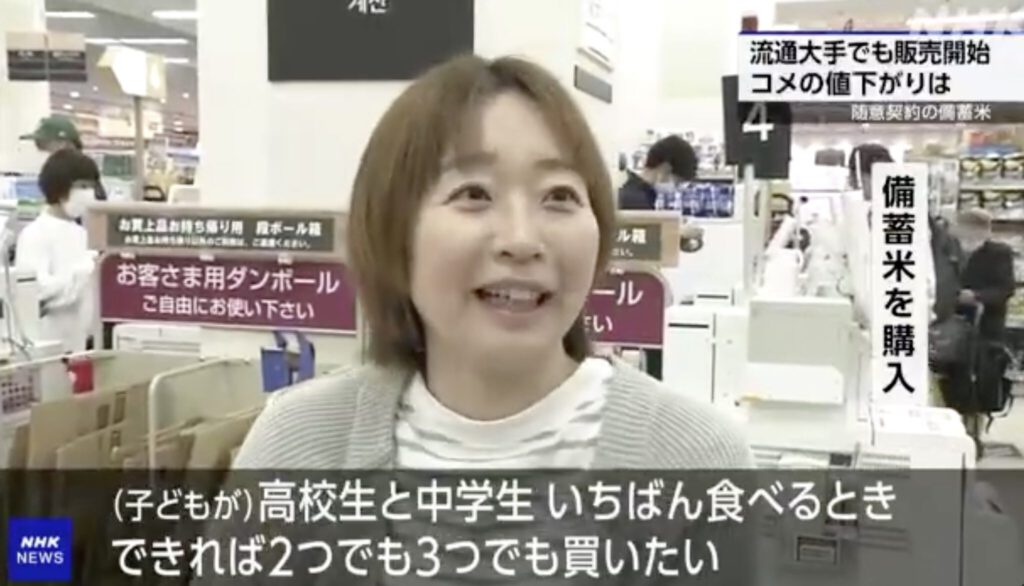
https://www3.nhk.or.jp/news/html/20250601/k10014822611000.html
2025年6月5日アップデート:
Japan convenience store chains start selling gov’t stockpiled rice
June 5, 2025
TOKYO (Kyodo) — Two major convenience store chains in Japan began selling government-released stockpiled rice at select stores in Tokyo and Osaka on Thursday, joining major supermarkets and e-commerce platforms in a move to increase availability of the staple food for consumers struggling with soaring rice prices.

The outlets of Family Mart Co. and Lawson Inc. will sell the rice from the 2021 harvest in small portions to make it affordable for people, including those living alone.
While many other retailers sell it in bags of 5 kilograms for about 2,000 yen ($14), Family Mart sets the price of its 1-kg package at 388 yen, and Lawson’s is at 389 yen and 756 yen for 2 kg. Both will limit their sales to one package per customer.
Lawson said it will make the rice available at its 13,800 stores nationwide on June 14, excluding those in Okinawa, while Family Mart said it will also expand areas selling them.
“If (Family Mart) provides the stockpiled rice nationwide, it will help expand access,” farm minister Shinjiro Koizumi said as he inspected a Family Mart outlet in Tokyo.
Seven-Eleven Japan Co. also said it will start selling stockpiled rice in some stores, including those in Tokyo and Osaka, on June 17 for 775 yen for 2 kg and gradually expand availability.
The three major convenience store chains secured stockpiled rice through direct contracts as small- to medium-sized distributors after being rejected as major distributors due to a lack of transaction history.
Some retailers that signed contracts as major distributors started selling the rice at the end of May and have already been running out of stock.
2025年6月6日アップデート:
小泉農相 随意契約の備蓄米“今月下旬~来月に相当量 市場に”
NHK 2025年6月6日 12時38分

これについて小泉農林水産大臣は6日の閣議のあとの会見で「コンビニでの普及を通じて北海道から沖縄まで面的な広がりをもって段階的に進んでいく。それに加えてまちのお米屋さんや中小スーパーとの契約を次々にやっていくことできめ細かい広がりが出てくる」と述べ、今月下旬から来月にかけて相当量の備蓄米が市場に出回るという見方を示しました。
そのうえで高騰が続くコメの値下がりに向けては「聖域なくあらゆることを考えてコメの価格の安定を実現していく」と述べ、「ミニマムアクセス」と呼ばれる仕組みで政府が輸入したコメの活用やコメの緊急輸入なども含め、あらゆる方法を検討していく考えを強調しました。
一方、価格高騰の要因とも指摘されているコメの流通の在り方については「ある卸売業者は利益が500%という話だ。いったいいくらで販売しているのか、どれぐらいのマージンをとっているのか、一つ一つ解明していく」と述べ、流通の現状を明らかにし、適正化を図る考えを示しました。
https://www3.nhk.or.jp/news/html/20250606/k10014827511000.html
Soaring rice prices in Japan spotlight rigid supply chain structure
June 6, 2025
TOKYO (Kyodo) — Rice moves through a multi-layered supply chain in Japan before reaching consumers, a structure that drives up costs and complicates market adjustments of the staple food, with retail prices currently standing at around twice the level seen a year earlier.
Farmers typically sell their harvest to collection agents, notably the Japan Agricultural Cooperatives, a powerful nationwide organization. The agents pass the rice to wholesalers, who then sell it to retailers such as supermarkets or specialty rice shops.
Each step in the chain adds transportation fees and profit margins that accumulate and are eventually passed on to households. Ultimately, rice prices at retail stores can be much higher than what farmers initially receive for their harvest.
One distinct feature of Japan’s system is that the JA, as the organization is known, offers advance payments to farmers. The provisional payouts help farmers cover living and operational costs before their rice is sold, but they also influence how prices are set throughout the supply chain.
Critics say the framework makes it difficult for rice prices to reflect market trends. Unlike in freer markets, where prices adjust based on supply and demand, Japan’s rice distribution is viewed as rigid, preventing flexible responses to sudden changes in demand.
Earlier this year, the government of Prime Minister Shigeru Ishiba began to release emergency rice stockpiles to address soaring prices. The reserves are generally saved for disasters or crop failures but are now being used as a temporary price control measure.
When the Ministry of Agriculture, Forestry and Fisheries was led by then minister Taku Eto, who has strong links to the farm industry, the stockpiled rice was released through auctions, allowing most of it to be purchased by the JA at high prices.
The total amount of reserve rice won by the JA at auction since March was about 296,000 tons, accounting for around 95 percent of the 312,000 tons released by the government, according to official data.
In May, however, Eto resigned over a gaffe involving rice gifts from supporters. His successor, reform-minded minister Shinjiro Koizumi, has shifted strategy by supplying the stockpiles through direct contracts with retailers including supermarkets.
By selling affordable reserve rice, Koizumi has pledged to push down prices across the board in Japan — an approach some analysts see as market intervention — so that consumers can obtain the staple food more quickly and at lower cost.
But skepticism is growing that the initiative will have a major effect, given that the volume of the stockpiles is small relative to total domestic demand and that only a limited number of retailers are handling the released rice.
The government essentially stores 1 million tons of rice by buying 200,000 tons annually from farmers over five years. Japan’s annual domestic rice demand, meanwhile, totals about 6.7 million tons, the ministry said.
On Thursday, Ishiba chaired the first ministerial meeting to discuss ways to ensure a stable rice supply.
2025年6月8日アップデート:
立民 原口元総務相“古古古米 ニワトリがいちばん食べている”
NHK 2025年6月7日 22時06分

立憲民主党の原口 元総務大臣は佐賀県内で開かれた会合で、備蓄米について「古古古米はニワトリさんがいちばん食べている。人間様は食べていない」などと発言しました。
立憲民主党の原口 元総務大臣は、7日佐賀県内で開かれた会合に出席し、自身があいさつした内容を旧ツイッターの「X」に投稿しました。
それによりますと、原口氏は「古古古米はニワトリさんがいちばん食べている。人間様は食べていない。恐ろしいでしょ」などと述べています。
また、備蓄米をめぐり、国民民主党の玉木代表が先に「1年たったら動物のエサになるようなもの」などと発言したことについて「玉木代表はたたかれているが、本当のことを言ったらいけないのか」と指摘しています。
この発言について原口氏は、その後「X」で「古古古米は3年以上経過したコメで一般的に食用には適さないとされている。これは常識だ。僕は謝る必要は全くない」などと説明しました。

Former Minister of Internal Affairs and Communications Haraguchi of the Constitutional Democratic Party of Japan: “Chickens eat most of the old rice”
NHK June 7, 2025, 10:06 PM
At a meeting held in Saga Prefecture, former Minister of Internal Affairs and Communications Haraguchi of the Constitutional Democratic Party of Japan said about stockpiled rice, “Chickens eat most of the old rice. Humans don’t eat it.”
Former Minister of Internal Affairs and Communications Haraguchi of the Constitutional Democratic Party of Japan attended a meeting held in Saga Prefecture on the 7th and posted the contents of his greeting on the old Twitter account “X.”
According to the article, Haraguchi said, “Chickens are the ones that eat most old, ancient rice. Humans don’t eat it. It’s scary, isn’t it?”
He also pointed out that, in response to earlier comments by Democratic Party for the People leader Tamaki about stockpiled rice, saying, “After a year, it’s like it’s going to become animal food,” he said, “Tamaki is being criticized, but shouldn’t he be telling the truth?”
Regarding this comment, Haraguchi later explained on “X,” saying, “Old, ancient rice is rice that is more than three years old and is generally considered unsuitable for eating. This is common sense. There’s absolutely no need for me to apologize.”
https://www3.nhk.or.jp/news/html/20250607/k10014828891000.html
「本当のことを言ってはいけないのか」備蓄米で原口一博議員【佐賀市】 (25/06/07 19:00)
サガテレビ ニュース
7 Jun 2025
立憲民主党佐賀県連の原口一博代表(衆議院議員)は、7日に佐賀市で開かれた会合で、コメの高騰や備蓄米について次のように話した。
【立憲民主党・原口一博衆議院議員】「先日、国民民主党の玉木代表とお話しをました。コメ、古古古米、あんなに恩着せられて買うものですか?あれ、5キロ83円ですよ。83円でそれ2000円以上で売っているわけです。それで私が通達を出したらコメが安くなりましたとか言ってる、うそでしょ。玉木代表この間ね、草場さん、叩かれてましたよね。本当のことを言っちゃいけないんですか。古古古米はニワトリさんが一番食べているんですよ。人間様は食べてないんですよ。おそろしいでしょう。私たちの言葉を奪いに来てるんです。この間玉木代表と話しました。玉木代表よりもっとひどいことまで僕は言ってたんですよ。玉木代表の影に隠れて僕は批判されなかったけど、いや、もっと強く言うよって言います。なぜならば、彼らこそが日本をよそに売り渡しているからです。私たちの暮らしの安心、あれなんでコメが足りなくなっているかというと、農業をバンバンにいじめたからです。生産政策をやらなきゃいけないんです。それを目先の価格政策でやったら、消費者と農家が対立するに決まっているじゃないですか。」
[Constitutional Democratic Party, House of Representatives Member Haraguchi Kazuhiro] “The other day, I spoke with Representative Tamaki of the Democratic Party for the People. Is it really worth buying old, very old rice when you’re being so beholden to them? It’s 83 yen for 5 kilos. At 83 yen, it’s being sold for over 2,000 yen. And now they’re saying that rice has become cheaper because I issued a notice? That’s a lie. Representative Tamaki, Mr. Kusaba, you were criticized the other day. Shouldn’t you be telling the truth? Chickens are the ones that eat most old, very old rice. Humans don’t eat it. Isn’t that frightening? What we’re saying is… They’re coming to steal the leaves. I spoke with Tamaki the other day. I’ve said even worse things than Tamaki did. I was hidden in Tamaki’s shadow so I didn’t get criticized, but I’ll say it even stronger. Because they are the ones selling Japan out to other countries. Our security in life – why are we running out of rice? It’s because we’ve bullied agriculture so much. We have to implement production policies. If we do that through short-term price policies, it’s inevitable that consumers and farmers will come into conflict.
In case of censorship:
Link_https://www.youtube.com/watch?v=vkV0DfDqqoc

2025/6/14 アップデート:
Japan to ban reselling of rice as cheap stockpiles hit shelves
June 13, 2025
TOKYO (Kyodo) — The government decided on Friday to prohibit the reselling of rice purchased at retail shops to ensure that rice reserves recently released at lower prices will stably reach consumers.
Under the ban, which will take effect June 23, those who sell rice at a higher price than they paid at supermarkets and online shops will face up to one year in prison, a fine of up to 1 million yen ($6,960), or both.
The move comes after the government took the rare step of selling rice reserves through direct contracts with retailers in late May, hoping to tackle rising prices of Japan’s staple food, which have doubled compared with a year earlier.
Farm minister Shinjiro Koizumi said the rice stockpiles are at “risk of resale because they are sold at cheaper prices.”
“It is necessary to develop an environment to deliver stockpiled rice to as many people as possible,” the agriculture, forestry and fisheries minister also said in explaining the need to impose the reselling ban.
The ban, stipulated in a revised Cabinet order under a law providing emergency measures in response to price rises, will also affect rice other than the government stockpiled rice.
Rice prices have spiked from the summer of last year, prompting the government to release its rice reserves that have been set aside for emergencies such as disasters or crop failures.
Japan has so far decided to release all but about 100,000 tons of reserve rice from its stockpile of 910,000 tons.
Local gov’ts in Japan providing ‘rice aid’ in vouchers, real grain, amid high prices
June 13, 2025
TOKYO — Local governments in Japan are carrying out “rice aid” programs for residents amid soaring rice prices, mostly using national subsidies designated to address rising costs as resources.
The Hokkaido Prefectural Government will hand out vouchers or digital coupons worth 5,240 yen (about $36) to purchase rice and milk, or distribute 5.5 kilograms of locally produced rice to each of some 390,000 households with children. The prefecture is accepting applications until the end of June.
The city of Kameoka in Kyoto Prefecture will hand out 5 kg of Japanese rice each to all children aged up to 18 in the city (roughly 12,500), as well as coupons worth 8,000 yen (about $56) that can be used at local shops in the city.

The city of Fukui will distribute 5,000-yen (approx. $35) vouchers for locally grown rice to some 24,000 families with children. The amount will be increased to 8,000 yen for single-parent households. The Hitachi Municipal Government in Ibaraki Prefecture will send out 4,400-yen (about $31) rice certificates to around 11,000 families with children.
The Osaka Prefectural Government has been carrying out a program to provide children aged 18 and younger and pregnant women with digital coupons or food items worth 7,000 yen (roughly $49). The prefecture announced in early June that the age bracket will be expanded to include those aged 19 to 22.
Meanwhile, some municipal governments include all residents and households for aid programs.
The city of Chichibu in Saitama Prefecture will distribute rice certificates to all 26,000 households in the city. The amount ranges depending on the number of household members: those with one to three members will receive certificates worth 2,200 yen (approx. $15) and those with four or more 3,080 yen (about $21). The city plans to send them out around late August.
The Toki Municipal Government in Gifu Prefecture will send out 4,400-yen rice vouchers per household to all of the city’s roughly 24,700 households, while Ehime Prefecture’s city of Imabari will hand out rice certificates worth 2,200 yen each to the city’s approximately 147,000 residents.
Many of the local governments are asking their residents not to resell these vouchers online.
クーポン券に現物支給 各地の自治体で「コメ支援策」続々
米価の高騰が続くなか、各地の自治体が住民向けの「コメ支援策」を次々と打ち出している。子育て世帯などを対象に、物価高騰対策の国の交付金を活用する事例が目立つ。
北海道は道内で子育てをしている約39万世帯に対し、コメと牛乳を購入できる5240円相当の商品券か電子クーポン、または道産米5・5キロを支給する。6月末まで申し込みを受け付けている。
京都府亀岡市は0~18歳の子ども全員(約1万2500人)に、国産米を1人5キロずつ支給。市内の商店で使える8000円分のクーポン券も配布する。
福井市は約2万4000の子育て世帯に対し、1世帯あたり5000円分の県産米の購入支援券を配る。ひとり親世帯には3000円分を上乗せする。茨城県日立市は、約1万1000の子育て世帯に「おこめ券」(4400円分)を送る。
大阪府は、18歳以下の子どもや妊婦を対象に7000円分の電子クーポンか食料品などを支給する事業を実施。6月上旬には、対象を19~22歳に拡大すると発表した。
全ての世帯や住民を支援対象とする自治体もある。
埼玉県秩父市は、市内の全2万6000世帯に「おこめ券」を配布する。1~3人の世帯には2200円相当、4人以上の世帯には3080円相当を8月下旬ごろに発送する計画だ。
岐阜県土岐市は市内の全約2万4700世帯に、1世帯あたり4400円分の「おこめ券」を発送。愛媛県今治市は約14万7000人の全市民に対し、1人あたり2200円分のおこめ券を配る。
多くの自治体は、インターネット上などで転売をしないよう呼びかけている。
https://mainichi.jp/articles/20250612/k00/00m/040/102000c



